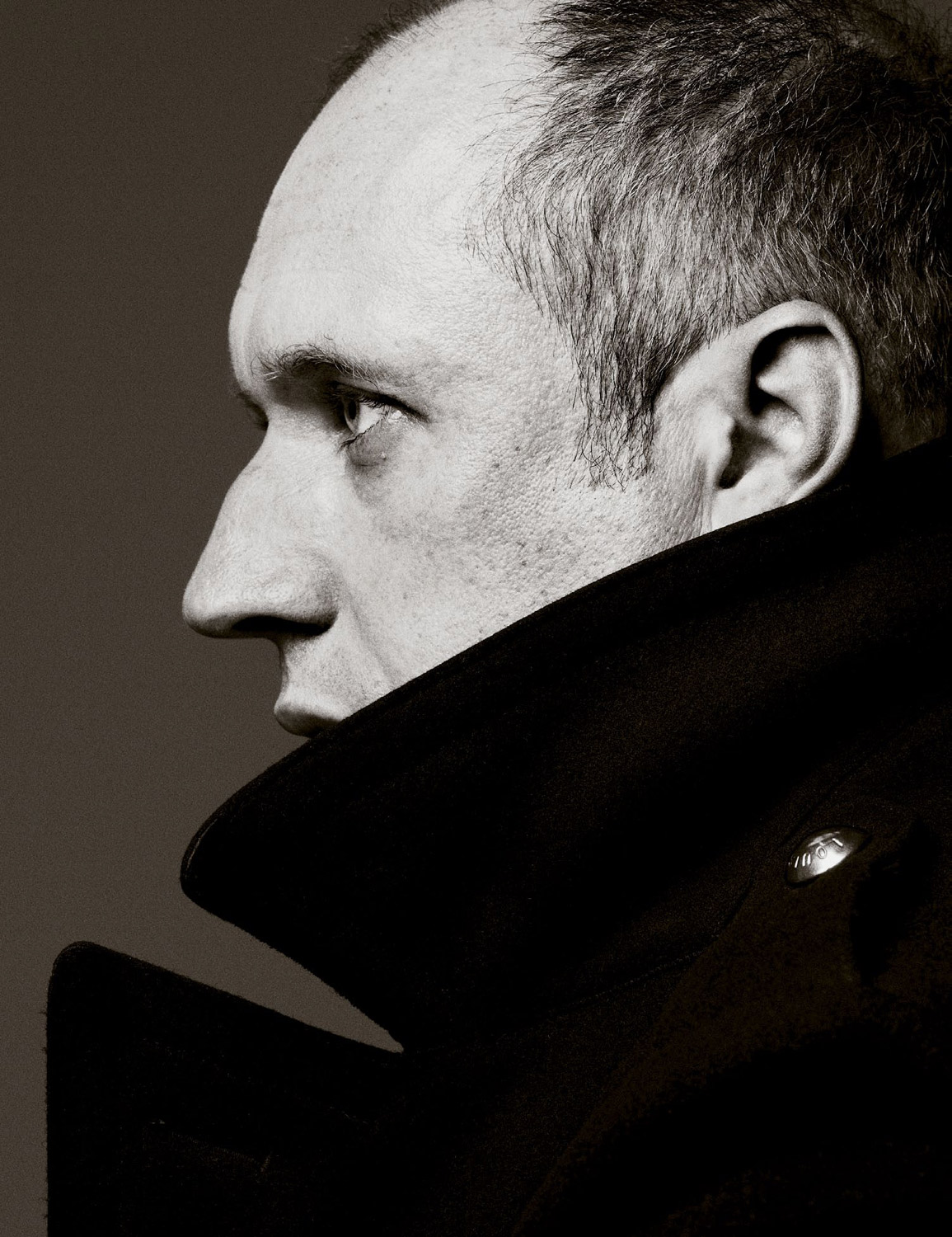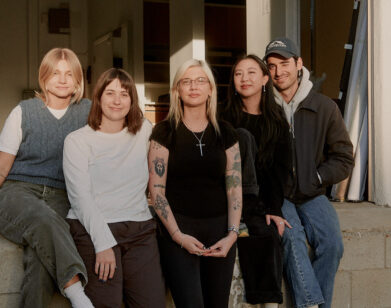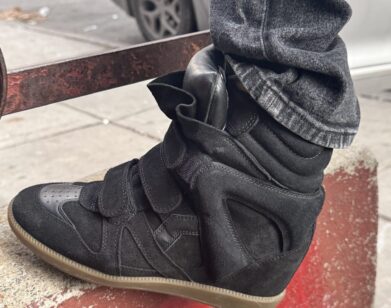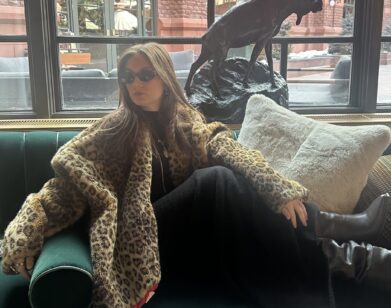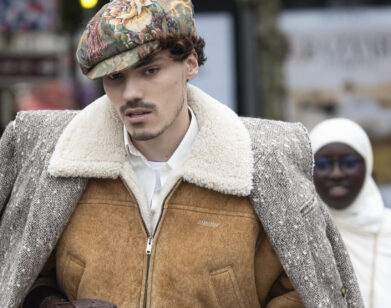Peter Copping
i became really interested in clothes very early. I was interested in anything beautiful.Peter Copping
Though he’s been at the helm of Nina Ricci for more than three years, Peter Copping has only recently gained notice beyond Parisian fashion circles. Reception of his earliest collections, beginning with Spring 2010, was positive, but coming on the heels of a critically and commercially uneven period for the brand (four creative directors had passed through the company in the previous 10 years), caution understandably preceded a full embrace of the British-born Copping’s arrival. With his Fall 2012 collection, however, the 45-year-old designer seems to have proven a canny choice as steward of Nina Ricci’s ultra-feminine legacy of romantic dressing. House staples such as liquid satin blouses, tweed jackets and skirts, and little black dresses are modernized and playfully distorted by overlong sleeves, asymmetrical fur collars, and an abundance of lingerie details like sheer silk insets and lace trim. The idea, he says, was to reintroduce some couture touches that connect to the Ricci past as well as to his own.
Copping’s first exposure to the rarefied world of haute couture came in 1990 while studying at London’s Royal College of Art when he was sent to Paris for an internship in the atelier of Christian Lacroix. After graduating, he went to work for the Italian company Iceberg, before returning to Paris in 1994 for a stint at Sonia Rykiel, and eventually, in 1997, a job with Louis Vuitton, where he worked alongside Marc Jacobs. Copping had spent a dozen years at Vuitton—his last post there was director of the womenswear studio—when he was tapped to help revive the Ricci brand. Established in 1932 by Maria “Nina” Ricci and her son, Robert, the label had always been identified more by a sensibility that telegraphed the ineffable chic of the jeune fille Parisienne than by a specific look (there is no Nina Ricci equivalent to the Chanel suit or YSL’s Le Smoking). Yet the unabashed prettiness of Nina Ricci’s clothes has always captured the mood of the moment, whatever the decade—a notion of timelessness that is bottled and concentrated in L’Air du Temps, the house’s enduringly popular perfume.
It’s that spirit that guides Copping, who is steadily and quietly shepherding the brand’s growth (a bridal line and expanded accessory offerings are future possibilities) while retaining the best of its history. Someone who has a few pieces of the Nina Ricci heritage history in her closet is Iris Apfel, an icon among style icons, who reached Copping by phone at his studio in Paris.
IRIS APFEL: Back in my Paris days, I used to go see the collections and buy afterwards.
PETER COPPING: That I knew, because a favorite book of mine is the one about your wardrobe [Rare Bird of Fashion: The Irreverent Iris Apfel by Eric Boman]. I was looking through it recently, and I saw all these Nina Ricci pieces that you bought in the past. It’s always nice to connect things to the history of the house. It seems like you had some great pieces, no?
APFEL: Oh, I think so. I kind of like offbeat things that nobody else wants. I like them doubly because they’re different. Sometimes I’d be hysterical about a piece, but I couldn’t afford it, and of course nobody else liked it, so I would wait a few seasons and the price would go down.
COPPING: Really?
APFEL: That was delicious. I loved that. Sometimes I got things for what you’d have to pay now for ready-to-wear.
COPPING: We no longer do haute couture.
APFEL: I know. Hardly anybody does.
COPPING: A little while ago, it seemed to be a dying industry, but I think there’s a lot of new life coming back to it. There are some new designers, like Raf Simons, who’s recently gone to Christian Dior. I think that’s going to give a lot of energy back to couture. There are new clients from the Middle East, and those women want really special things. So I think there’s a market for it.
APFEL: Oh, I hope so, because it really shouldn’t die.
COPPING: Do you still come to Paris sometimes?
APFEL: Well, I used to come twice a year, but my whole life has changed since my first show at The Metropolitan Museum of Art [“Rara Avis: Selections from the Iris Apfel Collection,” 2005–2006]. I’ve become a geriatric starlet.
COPPING: But that’s a nice position to be in, no?
APFEL: Well, at 90, it’s kind of fun. It beats going out to pasture, I’ll tell you that. I’m called upon to do all kinds of interesting things.
COPPING: And collaborating with M.A.C Cosmetics, no less.
APFEL: Oh, yes. I think I’m the world’s oldest-living broad to become the face of a cosmetics campaign. Harold Koda [The Costume Institute curator] at the Met said we have to put it in the book of records. It was great fun and a big success. I worked very hard on that. When I do something, I don’t just let them do it and put my name on it—I work at it.
COPPING: I think that’s true of all creative people. It becomes an obsession, and you can’t do anything by half.
APFEL: While you were growing up, did you think about a life in fashion?
COPPING: I’d definitely say I did. I was lucky in that I had liberal parents who very much encouraged me and my sister to pursue artistic paths. We grew up in the country, just outside Oxford, and had a very idyllic upbringing. My grandmother lived in half of the house, and we were in the other half. So I was surrounded by her and by my mother, and I became really interested in clothes very early. I was interested in anything beautiful. I loved antiques and paintings. I was quite a curious child and just liked looking at things. Then I went to London to study fashion at Central Saint Martins.
APFEL: That’s the best place!
COPPING: I feel lucky to have been there. Actually, it was a tough time, because just before I applied for my foundation course my mother passed away. It was when I was pretty young. She never even knew I got accepted.
APFEL: Oh, that’s sad.
COPPING: But my father really took over her role, and he always took such an interest in my studies and what I was doing. I feel very lucky that I was supported so much by my family. Because when I got to Saint Martins, my fellow students said, “Oh, god, my parents wanted me to become a doctor,” and it wasn’t an easy route for them, which I think is difficult.
APFEL: Do you remember what the first piece was that you designed?
COPPING: Oh, gosh . . . I can remember when I was young I used to make dresses for my sister’s dolls. I’d find scraps of fabric. I can remember having some amazing green lamé that I just loved, and making a little tunic dress. And when I was studying, I think one of the first pieces I designed was a pinstriped suit.
APFEL: A pantsuit or a skirt?
COPPING: It was a skirt, and the jacket was kind of cropped short. It was a time when Jean Paul Gaultier was riding the wave, and I was a big fan of his work, and I liked that whole androgyny thing—you know, men’s clothes for women. I can remember designing some pieces around that.
APFEL: So what about the inspiration for your Fall 2012 collection?
COPPING: Basically, I just wanted to play around with proportion. I found some images of girls in adult clothing, and what appealed to me about that contrast was how it changed the whole sense of proportion. So jackets had dropped shoulders and extremely long sleeves, and sometimes a look that was normally quite uptight and tailored—just by putting it on somebody who it wasn’t designed for gave it a whole kind of sense of ease. I love that there’s a Parisian sense to the clothes. There are some things that are constant season after season. The fabrics are always very luxurious. It was important to work with the heritage of Nina Ricci—to that French, Parisian style. But that’s a femininity that can appeal to women all around the world, you know?
APFEL: Oh, I would think so. I think Paris still carries a great mystique.
COPPING: I think it does. It’s a fantastic city. I’ve lived here for about 18 years now and I still love it. I still find it very inspiring.
APFEL: What about your own aesthetic? How has that evolved?
COPPING: I’ve always been drawn to the high-end luxury market. During my studies in Paris, I had an internship at Christian Lacroix. That really cemented the idea that Paris was where I wanted to be. And I spent a long time working with Marc Jacobs at Louis Vuitton. So over the years I’ve been in Paris, I’ve learned a lot. I’ve developed in terms of knowledge and savoir faire, but, basically, I think I’ve always had a pretty clear aesthetic, and my personal taste is very close to what I do at Nina Ricci. That allows me not to make too many compromises, which is a nice situation to be in.
APFEL: How would you define the woman you’re designing for?
COPPING: I think the first thing I would say is there’s a definite femininity, a sensuality. I think she can be sexy but never vulgar, and I think she contradicts herself sometimes because she can be fragile yet strong.
APFEL: I read somewhere—I love this line; I wrote it down—you said: “It’s about a strong woman who’s very feminine.” I think that’s great. Some people think if you’re strong, you can’t be feminine, or vice versa.
COPPING: That’s one thing I’ve never agreed with. Women have a lot of power. They’re career women, they’re mothers, often both at once. There are so many things they have to do now, but I don’t think that necessarily denies them wanting to be women either. You know, I think there are a lot of nice things in the collection that would look very good on you.
APFEL: Oh, good. I haven’t been shopping in the last year. First of all, I have so much stuff and I’m giving a lot away. I’m building a fashion department for the Peabody Essex Museum [in Salem, Massachusetts].
COPPING: Wow. That’s fantastic.
APFEL: So that’s one thing. And secondly, because my husband hasn’t been well, we hardly leave New York and we don’t go out nearly as much. I’m talking to you from Palm Beach. It’s the first time we’ve been down to our place in two years.
COPPING: How is it down in Palm Beach? Are you dressed in pastels today?
APFEL: No, I’m in my usual jeans. I’m 90 years old and somehow I’ve never gotten over it, but if I’m dressed properly, I can’t work. I have to kind of look raggedy.
COPPING: That’s funny, because I can imagine some people would be the other way around. What brand of jeans do you go for?
APFEL: I have every brand in the universe. I have skinny jeans and wide jeans and embellished jeans and embroidered jeans and beaded jeans and jeans that cost $10 and jeans that cost thousands.
COPPING: It’s funny you say that because just at the moment we’re working on our cruise collection, and we’re putting some denim into it this year. There are draped dresses, some trousers, and a trench coat—I thought that could be a good one for you.
APFEL: I’m such a fan of denim. I think it’s so fabulous. You can do so many things with it.
COPPING: What I’ve always loved about you, and the way you dress, is that you really project your personality onto the clothes. You wear very strong pieces yet they don’t dominate you. It’s always really important that the personality of the woman comes through.
APFEL: How do you feel about aging and ageism? What do you think about that?
COPPING: Something I’ve been really happy about since I’ve been at Nina Ricci is that we have a really broad age range of clients: We have mid-twenties to much more mature women. I think aging is something women have to embrace.
APFEL: I don’t know if it’s this way in France, but we have such a mania with youth here, it’s absolute insanity. The American woman is consciously and subliminally bombarded with this idea that you’re not supposed to ever look a day over 18. It has become an obsession and a great problem—you have no idea.
COPPING: The models in our fashion shows are so young, and I often ask myself the question, “How do the women, the clients, relate to that?” I do find it a strange situation.
APFEL: I find it very strange, because most of the models, as beautiful and lovely as they are, don’t know how to wear clothes. Can you think of anyone you consider a style icon of this generation?
COPPING: The style icons of this generation . . . wow. As soon as I hear that question, my mind goes a bit empty, but I know that later I’ll think of some people I should have said. I think you have to have a kind of level of confidence as well. Kate Moss has had a huge influence on how people dress, especially young girls in England. I think of someone like Angelina Jolie, when she was at the Oscars. She’s an incredibly beautiful woman, and she had such a presence, which made her quite amazing to look at. I don’t know if that makes her a style icon, but I do think she’s someone who knows how she looks good and who wears clothes well.
APFEL: Where do you see the Nina Ricci brand in the next 10 years?
COPPING: I’ve been here for three years, and I’m trying to define what the style is for the house now, and I like to keep an element of consistency overall in the collections. And I think that’s important for any woman looking at the brand, that there’s always a certain level of product she will find. The next few years are a time when we can grow. We’re opening a store in London in September, at Mount Street, so that’s an exciting project.
APFEL: I hope you open up a shop in New York.
COPPING: There was one thing I was going to say: What I love about your look is the ethnic mix and the use of fur and Native-American jewelry or other pieces you’ve found on your travels. The thing I think is great about America is—and everyone says England has so many strong personalities and eccentrics—but I think America really nurtures individuality as well. I’m not saying you’re eccentric, but when I come to New York, I see these amazing people walking around, and for me, you are very much one of those people.
APFEL: Do you feel very Parisian now because you’ve been there so long? Or do you still feel like an Englishman?
COPPING: I think I’ll always feel like an Englishman. I love my life in Paris, and I really have made my home here, but at the end of the day, I am an Englishman. Always will be, I think.
Iris Apfel’s latest handbag collection, Extinctions, will be in stores this fall. She lives in New York and Palm Beach.

